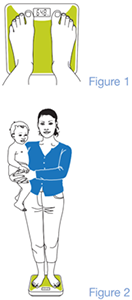Weighing Infants and Children
To be used to assign a score for step 3 of STAMP.
Preparing to weigh an infant or child
- Ensure the scale is on a flat, hard, even surface. Make sure the power source is turned on.
- Explain all procedures to the parent/carer.
- Infants should be weighed unclothed. Children should be weighed wearing minimal clothing.
- Make sure the scale display reads '0' prior to use.
- All weights and measures should be checked for accuracy and calibrated regularly.
- To maintain hygiene, wipe the scale down between weighings.
Tared weighing: for infants <2 years old or children who won't stand still
- The parent/carer should stand barefoot in the middle of the scale with feet slightly apart, and remain still until his/her weight appears on the display (Figure 1).
- Note the weight of the parent/carer.
- Hand the unclothed infant to the parent/carer.
- When both the parent /carer and infant are still, record the weight to the nearest 0.1kg (Figure 2).
- Subtract the parent/carer's weight from this figure to obtain the child’s weight.
- If the parent/carer is very heavy, e.g. more than 100kg, and the infant is relatively light, e.g. less than 2.5kg, the infant's weight may not register on the scale. In such cases, ask a lighter person to hold the infant.

Weighing an infant alone: for infants <2 years old who will lie still
- Place a thin piece of cloth or soft paper into a pan scale.
- Lie the unclothed infant on the cloth or paper and wait for him/her to stay still, to allow the scale to settle.
- Record the infant's weight to the nearest 0.1kg.
Watch Clinical Demonstration
Weighing Infants
Weighing a child alone: for children ≥2 years old who will stand still
- The child should stand barefoot in the middle of the scale, with feet slightly apart, and remain still until his/her weight appears on the scale display (Figure 3).
- Record the child's weight to the nearest 0.1kg.
